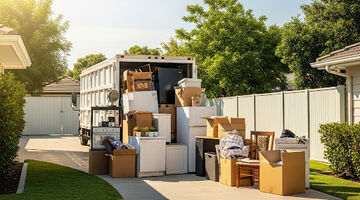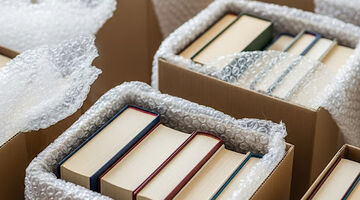Moving is always stressful, especially when you have to pack fragile items. Broken vases, crockery and glassware require special attention, because one wrong move and the item could be ruined. How to pack fragile items for moving correctly? The main thing is neatness and reliable materials. Bubble wrap, dense cardboard and soft fillers will help to preserve the integrity of the items. It's important to carefully secure each item, avoiding empty boxes. Then the move will go without unpleasant surprises.
Prepare Essential Packing Materials
Properly packing fragile items starts with preparing the materials. You'll need sturdy boxes, bubble wrap, packing paper, tape and soft fillers. Quality materials reduce the risk of damage during the move. Don't skimp on packing - it's better to stock up on everything you need in advance than to regret broken items later.
Set Up a Dedicated Packing Area
Set aside a separate place to pack fragile items. This can be a table or a clean part of the floor where you can lay out items and materials neatly. Working in an organised space speeds up the process and reduces the risk of accidental damage.

Protect Each Item with Individual Wrapping
What is the best way to pack fragile items? Each item should be wrapped separately. Use bubble wrap or soft paper, especially for glass and ceramics. Corners and fragile parts need extra protection. This prevents items from banging against each other during transport.
Ensure Adequate Padding for Safety
Even well-packed items can suffer damage if the box is not sufficiently cushioned. Fill voids with soft materials such as foam, paper or cloth. This will soften the impact and prevent items from shifting inside the box.
Prevent Overloading Boxes
Overloaded boxes are a common cause of damage. It is better to pack fragile items in small boxes, distributing the weight evenly. This makes them easier to carry and minimises the risk of crushing or bumping.
Secure Boxes with Strong Seals
Sealing boxes securely is key to keeping fragile items safe when moving. Use wide packing tape and carefully seal all seams and corners. Pay special attention to the bottom of the box, as it is the most stressful part of the box. Additional strips of tape around the perimeter will increase the strength of the package. Remember that weak spots may cause the box to tear and the contents to be damaged during transport.
Clearly Mark Each Box for Easy Identification
Tips for packing fragile items include mandatory labelling of each box. Use brightly coloured stickers or markers indicating ‘Caution! Fragile!’ and the “Up” side. Add a brief description of the contents to make unpacking easier. For particularly valuable items, mark ‘Open First’. Clear labelling will help the movers to handle the boxes carefully and place them correctly in the vehicle.
Keep Fragile Items in Separate Containers
Fragile items should always be transported separately from heavy and unbreakable items. Allocate special medium-sized boxes with reinforced walls. Do not mix crockery, glassware and crystal with books or appliances - this increases the risk of damage. If you don't have a lot of stuff, you can put padded dividers inside the box. This approach will provide extra protection and make unpacking at the new location easier.
Use Protective Inserts for Glassware and Dishes
When packing glassware and fragile plates, conventional wrapping may not be enough. What to use to pack fragile items as securely as possible? Special cardboard dish dividers are the ideal solution. They secure each plate or saucer separately, preventing contact and impact. For glasses and flutes, use thick paper inserts or foam holders to protect the thin legs. Don't forget to fill the empty space in the box with soft materials to prevent the contents from shifting during transport. This method of packing is especially important for antique china and expensive services that require careful handling.
Take Extra Precautions with Electronic Devices
Household appliances and electronics require special handling when moving. Even if the unit seems sturdy, internal components can be damaged by vibration and sudden movements. First of all, disconnect all wires and carefully pack them separately. Use the original packaging if it is still intact - it is best for transport. If there is no box, wrap the device in several layers of bubble wrap, paying attention to corners and screens. Be sure to secure moving parts, such as laptop lids or microwave doors. For particularly valuable appliances, consider professional packaging with anti-static protection.
Avoid Last-Minute Packing on Moving Day
Packing fragile items in a hurry is a sure way to cause damage. Start packing breakable items at least a few days before the move so that you can do everything carefully. The last day is best spent checking boxes that have already been packed and organising loading. Rushing leads to things being packed carelessly, without enough protective materials. In addition, in the rush, you may forget to label boxes or put fragile items together with heavy ones. Making a packing plan in advance and dividing tasks into days will help save your nerves and the integrity of your belongings. Remember - the smoother the process, the safer it is for your belongings.
Account for Items Sensitive to Temperature Changes
Some items require special transport conditions due to sensitivity to temperature fluctuations:
- Paintings and photographs - may warp from heat or moisture.
- Vinyl records - risk warping in a stuffy car
- Cosmetics and medicines - many products deteriorate at high temperatures.
- Musical instruments (especially wooden instruments) - suffer from dryness or dampness.
- Electronics with batteries - overheating is dangerous to batteries
For protection, pack such items in thermally insulating materials (e.g. foil film) and transport them in the car interior, not the boot. Use cooling packs in hot weather and thermal bags in cold weather.
Consider Insurance for Added Protection
Even with the most careful packing, fragile and valuable items can be damaged during a move. To protect yourself from unforeseen situations, it is worth considering cargo insurance. Many transport companies offer insurance for transported property, which is especially important for antiques, expensive electronics or art objects. Before taking out insurance, carefully study the terms and conditions of the contract - which cases are covered, how the damage is assessed and what the compensation procedure is. Some policies provide protection not only against damage, but also against theft or natural disasters. Although this will incur additional costs, the peace of mind that your valuables are safe is worth it.
Unpack Carefully to Prevent Damage
The unpacking process is just as important as the packaging itself - it is at this stage that unfortunate damage often occurs. Start with boxes labelled ‘fragile’ and release their contents on a soft surface. Do not rush to cut through packaging materials - first make sure the item is not jammed and does not require special care to remove. Pay special attention to multi-layer packaging: remove the protective layers one by one, checking the condition of the item at each stage. If any items were disassembled before the move (e.g. furniture legs or light fittings), reassemble them strictly according to the instructions, without using excessive force.
Seek Assistance from Moving Professionals
When it comes to transporting particularly fragile, heavy or valuable items, professional help can be indispensable. Specialised transport companies not only have the appropriate equipment and packing materials, but also the necessary expertise to transport them safely. They can offer customised solutions for pianos, sculptures, large mirrors or collectibles. To be sure that your things will be packed securely, you can order the services of packers in San Francisco, Sacramento and other cities.
 Same-Day Junk Removal: Declutter Your Space
Same-Day Junk Removal: Declutter Your Space
 How to Pack Books for Moving
How to Pack Books for Moving
 Best neighbourhoods in San Francisco
Best neighbourhoods in San Francisco
 California Car Registration and California Driver License
California Car Registration and California Driver License
 How Much Do Movers Cost In 2025
How Much Do Movers Cost In 2025
 Life in San Diego: Essential Information Before You Relocate
Life in San Diego: Essential Information Before You Relocate

